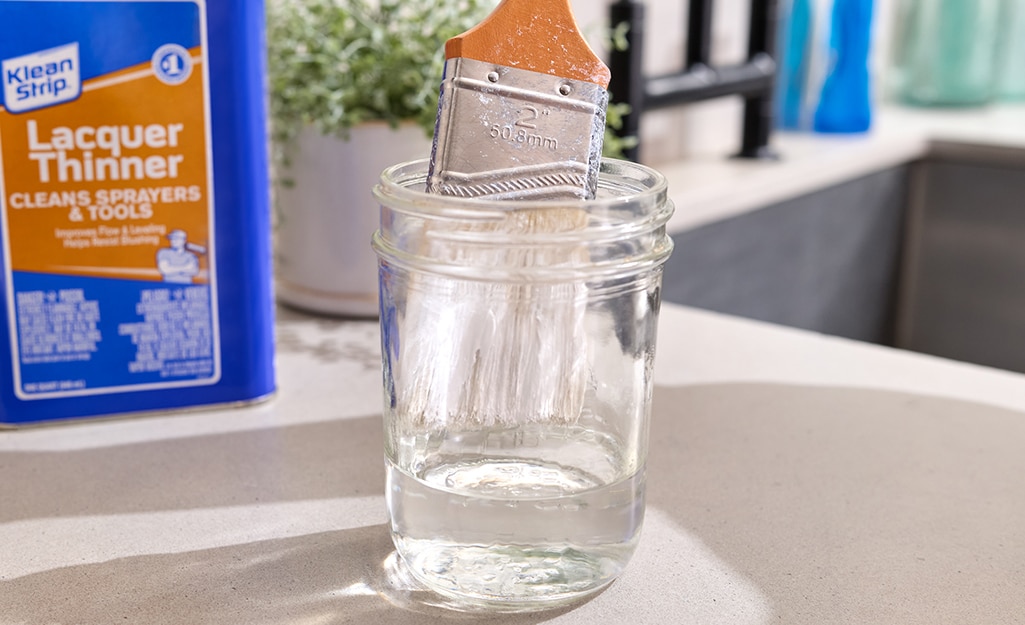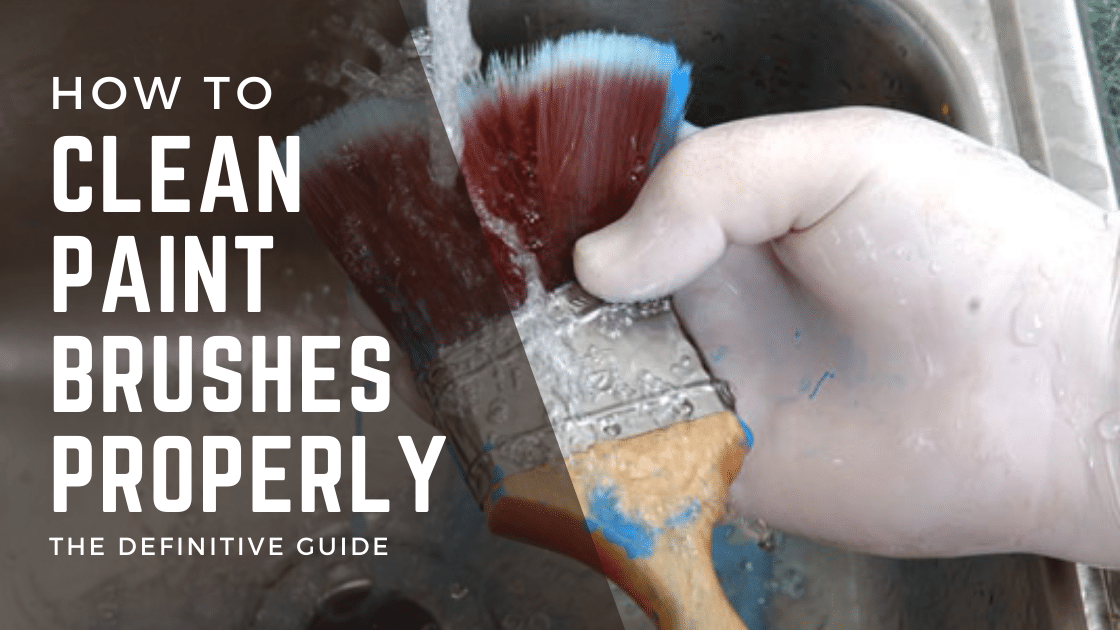Published by Hala Zaqqout on May 8, 2022 | Last updated on January 9, 2023
If you want to dive into a new painting project, the last thing after a hard day of painting is to clean painting brushes. When painting, you don’t want to skimp on brush cleaning; otherwise, you risk ending up with a frayed or crusty brush that is no longer useable.
Neglecting to clean your brush after a painting session might harm the bristles of your brush, whether you’re using a commercial brush to paint wall trim or an art brush on a canvas.
Cleaning your brush keeps paint from drying in the bristles, hardening it, and harming the fibers. Brushes that haven’t been thoroughly cleaned can also discolor your paint job.
Luckily, there’re many effective methods that help to clean paint brushes and prolong their life. So how to clean paint brushes?
Don’t Panic, Cleaners Advisor is here to help! In this guide, you’ll learn how to clean paint brushes properly in order to maintain brush quality and protect your paints with some easy steps. Then you’ll find cleaning tips to care for your paint brushes.
What Tools Needed to Clean Paint Brushes?
Before telling you how to clean paint brushes, there’re many tools and materials that come in handy needed to properly clean your paint brushes, but the most essential are:
1. Lukewarm Water

To loosen dry paint in your brushes, use lukewarm water and rinse off the excess paint.
Make a water bath in a utility sink to clean paint brushes or clean brushes under a running faucet.
2. Brush Comb

Use a brush comb to remove extra paint from paint brushes while they are being washed in lukewarm water. Brush combs, like paint brushes, should be cleaned on regularly.
Because the wire brush removes the filaments (or splits) at the end of the brush bristles, a brush comb is preferable to a wire brush.
3. Dish Soap

When cleaning brushes, a small amount of liquid dish soap or hand soap can go a long way. You can either simply apply mild soap on the brushes or pour it into the sink to create a soapy water bath.
Brush the brush bristles clean in lukewarm, soapy water before washing them in soap-free water.
4. Solvents

As brush cleaners, different paint jobs need different solvents. Use turpentine or mineral spirits with oil paints. Use denatured alcohol to make shellac.
Because solvents are highly potent, always open a window or use them in well-ventilated areas.
How to Clean Paint Brushes Properly?
When you’re done painting using a brush, clean it soon away to prevent paint from drying on the bristles. Follow this simple for cleaning paintbrushes, and you’ll have gleaming new paintbrushes for your next painting:
1. Remove Excess Paint
Squeeze out more paint by pressing the bristles against the inside of the paint can and lifting it up and out as you do so.
Cleaning a brush is made easier if you remove as much paint from its bristles as possible, so paint away the rest on newspapers. Then, remove any unused paint from your brushes with a paper towel or rag before cleaning with water.
2. Clean with Solvent
Use just enough paint thinner or solvent to submerge the bristles in a bowl for cleaning water-soluble paint, then stir the brush for about 20 seconds. Wipe the brush on the bowl’s side as needed until no more paint is visible on the brush.
You may need to soak the brush in vinegar for 1-2 hours to loosen dried paint with dried paint.
3. Clean with Water and Soap
Rinse the remaining paint and solvent with lukewarm water. To keep the bristles looking new, add some soap and massage the brush with your fingers to remove any excess paint.
Keep the handle up top and the bristles facing down to avoid too much water getting into the ferrule—the metal band that connects the bristles to the brush handle.
4. Rinse with Warm Water
Work the bristles of your brushes with your hand once the paint has been removed, spin the brush again, and then rinse it in another pail of clean water. Soap-free water can now be used to rinse them.
To give your brushes a last rinse, use lukewarm water to avoid loosening and expanding the ferrule.
5. Shake or Spin the Paint Brushes Dry
Remove all of the water from the bristles of your paint brushes before storing them. You can shake the brush in the bucket’s top and then wipe it dry with a clean rag, paper towels, or newspaper.
A brush and roller spinner, on the other hand, would come in handy for people who plan to do a lot of painting and want to keep their tools in good condition. Using centrifugal force, this dual-purpose tool will speed-dry any kind of paint applicator.
Simply attach a paint brush to the tool’s bottom, then pump the top several times to spin it and hurl all of the water off the brush’s business end.
6. Store Your Brushes
Paint brushes must be stored properly in order to maintain their form. Dry brushes can be hung by the handle or laid flat on a surface.
Hanging paint brushes from a pegboard in your workshop or craft room is not only a great way to keep them organized, but it also ensures that the bristles don’t be bent out of shape if they’re stuffed in a bin.
To keep your paintbrush in good condition and extend its useful life, replace the packing. Before starting your next work, make sure the paint brushes are completely dry.
Watch this video to learn how to clean paint brushes and keep them in a good condition.
Cleaning Tips to Care for Your Paint Brushes
Here’re some tips to follow in order to maintain brush quality and protect your paints:
1. Choose the Right Paint Brush
The first thing to keep in mind is that a good paintbrush will always last longer and be easier to clean than a cheap one.
Investing in a quality brush will pay off in the long run when it comes to cleaning it – and you’ll be more driven to keep it clean.
2. Don’t Overload the Brush
You should never use more than a two-finger width of paint on your brush. Never, ever, ever! The ability of the bristles to move and bend in the direction you want them to is crucial to having a paintbrush that works well for you and is simple to use.
It’s far more difficult to properly clean a paintbrush when you overload it and allow the paint to get all the way down to the base of the brush. As a result, when it dries, the bristles stiffen, making the brush more difficult to use.
Because you used too much paint at once, that brush will quickly become ineffective over time. The brush on the left has been appropriately loaded, whereas the brush on the right has been overloaded, as you can see in the photo below!
3. Store Properly Between Sessions
Paint will dry out if you don’t store your paintbrush properly, and your brush will become gross and unusable.
Wrapping a paintbrush in plastic wrap (or an old grocery bag) and storing it in the refrigerator is the easiest way to store it between painting sessions. You can buy fancy little plastic paintbrush coverings, but good ol’ plastic wrap or a plastic bag is more than enough.
How to Clean Paint Brushes FAQ
To Wrap Up
You now know how to clean paint brushes overnight. Cleaning paint brushes is a pretty simple task if you follow Cleaners Advisor guide above.
But most importantly, follow the tips above if you don’t want to risk ending up with a frayed or crusty brush that is no longer useable.
Still need to know anything about how to clean paint brushes? Leave us a comment below and we’ll get back to you as soon as possible.


![Criterion Dishwasher Reviews [According to 2023 Tests]](https://cleanersadvisor.com/wp-content/uploads/2023/03/Blog-Banner-for-Website-Content-41-350x190.png)
![Zline Dishwasher Reviews [According to 2023 Tests]](https://cleanersadvisor.com/wp-content/uploads/2023/03/Blog-Banner-for-Website-Content-42-350x190.png)

![GE Dishwasher Reviews [According to 2023 Tests]](https://cleanersadvisor.com/wp-content/uploads/2023/03/Blog-Banner-for-Website-Content-37-350x190.png)
![Miele Dishwasher Reviews [According to 2023 Tests]](https://cleanersadvisor.com/wp-content/uploads/2023/03/Blog-Banner-for-Website-Content-34-350x190.png)
![Cove Dishwasher Review [According to 2023 Tests]](https://cleanersadvisor.com/wp-content/uploads/2023/03/Blog-Banner-for-Website-Content-31-350x190.png)